Bay CrossingsGardens
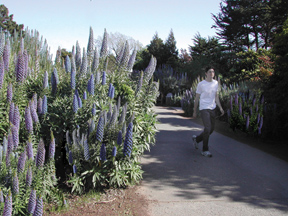 By Mary Swift Swan, Bayside Gardens of
Tiburon and Botany Bob
By Mary Swift Swan, Bayside Gardens of
Tiburon and Botany Bob
The beginning of spring is a beautiful
time of the year. It is fun to get out just to see the show
from late February to May. Some flowers bloom for a few days
others up to six weeks but then another bursts into a blaze
of color. Stunning flowers are seen in the hills, along the
walking paths, roadways ,and waterways all around the San
Francisco Bay Area. To provide information on what is
blooming this month, Bayside Gardens owner Matt, manager
Dennis, and their plant expert Botany Bob have lent their
expertise to “Bay Crossings Gardens.”
Botany Bob said, “Blue is a rare color in
tropical flowers. It is a spectacular color to see in a
flower. In the San Francisco Bay area with many micro
climates, some are within the range of Mediterranean weather
patterns with the most notable “Rivera Zone” being Tiburon
and Belvedere. Blue flowers in March include Ceanothus,
Lupine, and Pride of Madeira. We also have gold in them thar
hills with fields of Mustard, Poppies, and hedges of Cape
Honeysuckle, just to name a few.” Since this is the
celebration issue of Blue & Gold’s 25th Anniversary and a
special feature about Tiburon Waterfront Living, we begin
the Garden series with a few of the Blue and Gold flowers
that will cloak our surroundings in glorious color.
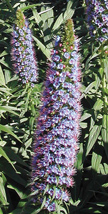 Exotic-adapted
Exotic-adapted
PRIDE OF MADEIRA– Echium fastuosum, also known as E.
candicans. Echium: from Greek echis, “a viper,” the blooms
appearing to represent a viper’s head (ref. genus Echium)
fastuosum: proud (ref. Echium fastuosum, Venidium fastuosum)
Think of a proud cobra rising to the song of the flute
player. So the sun calls at the end of winter for this plant
that is the Pride of the island of Madeira, in the
Mediterranean sea, to rise in full color and sway to the
gentle sea breezes along Tiburon’s recreation trail that
starts near downtown stretching along the shores of
Richardson Bay to Blackies Pasture.
Pride of Madeira is an evergreen perennial that can stop
traffic with its showy display in spring of blue, purple,
and sometimes pink bloom clusters. Some clusters show all
three colors at the same time. Pride of Madeira blooms
profusely for about six weeks but can continue thru summer.
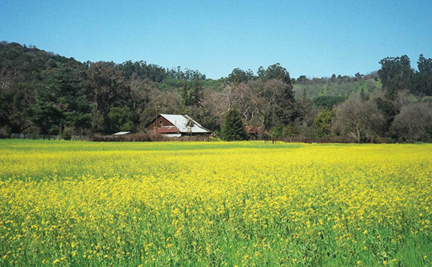 Pride of Madeira feels at home in the Tiburon Mediterranean
climate where, after the fog dissipates, there is very
little humidity. “It grows like a weed here! It doesn’t need
to be watered in summer,” said Matt. “It grows rapidly to
form a 6’ tall multi-branched bush with gray-green leaves
then begins to spread at its base. I need to have half a
truckload of Pride of Madeira with root balls wrapped in
burlap on hand by early March when they burst into full
bloom or I have a line of very unhappy customers.” Many from
around the Bay Area think of them as a native plants, but
they are a well-adapted exotic that grow with little care by
the Bay. They also grow in inland areas with sun and good
drainage.
Pride of Madeira feels at home in the Tiburon Mediterranean
climate where, after the fog dissipates, there is very
little humidity. “It grows like a weed here! It doesn’t need
to be watered in summer,” said Matt. “It grows rapidly to
form a 6’ tall multi-branched bush with gray-green leaves
then begins to spread at its base. I need to have half a
truckload of Pride of Madeira with root balls wrapped in
burlap on hand by early March when they burst into full
bloom or I have a line of very unhappy customers.” Many from
around the Bay Area think of them as a native plants, but
they are a well-adapted exotic that grow with little care by
the Bay. They also grow in inland areas with sun and good
drainage.
The plants will need protection from all
but light frost if taken to other areas, but are thankfully
deer resistant once established. The large, intense blue
flowers stand high above the foliage to make a brilliant
garden backdrop display. Use for a sunny pathway, on a hill,
or in a garden. It is an effective 6’ screen plant. Remove
spent flowers and prune lightly after flowering to maintain
bushiness. Bayside Gardens provides excellent planting
instructions for this beautiful plant in many locations.
“People are stunned by this plant,” said Matt. “We have
helped people from all over the country take this beauty
home, even to Iowa.”
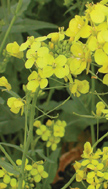 Imported-Exotics
Imported-Exotics
Mustard flowers pop up profusely where previously tilled
fields have yet to be sown for the new season. Mustard
blooms between thevines in wineries and fields of those who
supply our farmers’ markets. The fields thick with Mustard
are short-lived because at planting time they are plowed
under the soil to compost with fertilizer to nourish the
crops. It is considered a weed. It is not native to
California. Mustard is part of the cauliflower, broccoli,
kale and Chinese mustard family. Fully mature leaves can be
cooked, but tender new leaves can be used in salads. It
grows well in coastal regions. Since mustard-family members
usually, but not always, blossom in the spring, they tend to
have white or yellow blossoms — bright colors highly visible
to pollinators in spring’s dim sunlight.
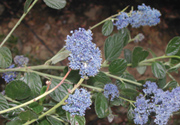 Endemic
Endemic
RAY HARTMAN CEANOTHUS– Ceanothus cuneatus, Wild California
Lilac.
Botany Bob says this plant is one of the most spectacular
plants in the world. It is endemic to California which means
it can be grown in other areas but it originated from
California. It is often used in highway and city landscaping
all around the greater San Francisco Bay Area.
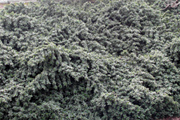 Botany Bob’s favorite plant is sometimes called California
Lilac. Ceanothus range in height from short, matted forms to
tall tree-like shrubs. It usually flowers in March and
April. The flowers vary from white to lavender to dark blue,
depending on the species. What looks from a distance like a
single long flower is really a cluster of many tiny
flowers. The flower groups are usually up to two inches
long. Most Ceanothus in California are evergreen. One of the
more common native species of Ceanothus is Ray Hartman
Ceanothus. Its blossoms are white or sometimes light
lavender, and the shrub usually grows up to 8’ tall. This
and other Ceanothus add beautiful color to our spring
landscape. It is best to protect until established as a
bush, then it becomes deer resistant.
Botany Bob’s favorite plant is sometimes called California
Lilac. Ceanothus range in height from short, matted forms to
tall tree-like shrubs. It usually flowers in March and
April. The flowers vary from white to lavender to dark blue,
depending on the species. What looks from a distance like a
single long flower is really a cluster of many tiny
flowers. The flower groups are usually up to two inches
long. Most Ceanothus in California are evergreen. One of the
more common native species of Ceanothus is Ray Hartman
Ceanothus. Its blossoms are white or sometimes light
lavender, and the shrub usually grows up to 8’ tall. This
and other Ceanothus add beautiful color to our spring
landscape. It is best to protect until established as a
bush, then it becomes deer resistant.
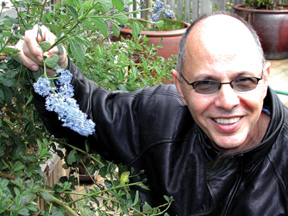 Wild flowering plants begin to turn the hills, waterfront,
and greater Bay Area of San Francisco into a kaleidoscope of
color beginning in March. The hills and fields seem to come
alive. Wild flowers are beautiful, delicate, and a beauty to
behold. The joy in picking them is short-lived because wild
flowers do not last like cultivated flowers. If left alone,
they seed for the next season after flowering, so picking
them is discouraged. Take pictures while they bloom to enjoy
them for years to come.
Wild flowering plants begin to turn the hills, waterfront,
and greater Bay Area of San Francisco into a kaleidoscope of
color beginning in March. The hills and fields seem to come
alive. Wild flowers are beautiful, delicate, and a beauty to
behold. The joy in picking them is short-lived because wild
flowers do not last like cultivated flowers. If left alone,
they seed for the next season after flowering, so picking
them is discouraged. Take pictures while they bloom to enjoy
them for years to come.
White Silene–Uniflora (maritaman) Perennial Zones 1-9, 14-24
from coastal regions of western and northern Europe. The
gray leaves with 6-8” stalks have abundant 4-petal flowers
that bloom for 4-6 weeks primarily March to April. It is
very common to see a wild version blooming with poppies or
lupine.
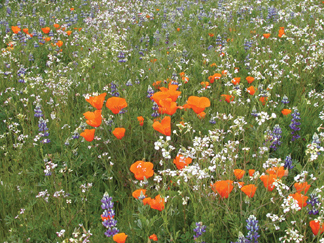 Native
Native
California Poppy–Eschscholzia Californica Begins blooming in
March and peaks in April. Native to Oregon and California
but can be grown from Northern Canada to San Diego, Zones
1-26. It is bothered by humidity, preferring dry climates
like the Mediterranean. Poppies are common all over the
world. Considered a perennial but often grown as an annual.
In mild climates like the Bay Area, it appears as clumps,
and spreads seeds to create other centers of brilliant
color.
Lupine – Lupinus bicolor Blue and white native flower that
blooms in March. Lupine has many varieties. It is an annual
in California and can be found all the way to British
Columbia, Zonee 3-24. Blooms from mid-March thru early
April.
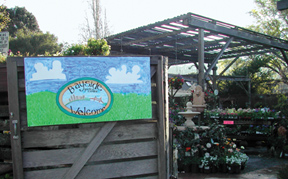 Botany Bob said, “California is the Number
One state in the U.S. with the longest list of endangered
native and endemic plant species. It is also Number One
among states that has the most to offer in native ornamental
plants that can be moved successfully to other areas. This
makes the situation especially sad; losing so many native
plants to development and aggressive exotics that do not
adapt well, Next to California, Texas is second and Hawaii
is third with the longest lists. Hawaii is now third because
many of their plants are already gone.” Bob adds, “With wild
flowers and native plants, it is a race between gone and
going away.”
Botany Bob said, “California is the Number
One state in the U.S. with the longest list of endangered
native and endemic plant species. It is also Number One
among states that has the most to offer in native ornamental
plants that can be moved successfully to other areas. This
makes the situation especially sad; losing so many native
plants to development and aggressive exotics that do not
adapt well, Next to California, Texas is second and Hawaii
is third with the longest lists. Hawaii is now third because
many of their plants are already gone.” Bob adds, “With wild
flowers and native plants, it is a race between gone and
going away.”
We want our readers to enjoy the beauty
and wonder of these beautiful flowers and plants, so we
encourage you to take a walk on the wild side or maybe plant
a few specimens to keep them around.
If you have any questions about plants or what and how to
plant your garden, call Bayside Gardens at (415) 435-0041